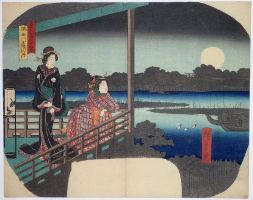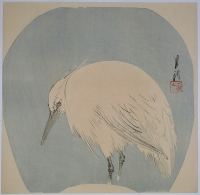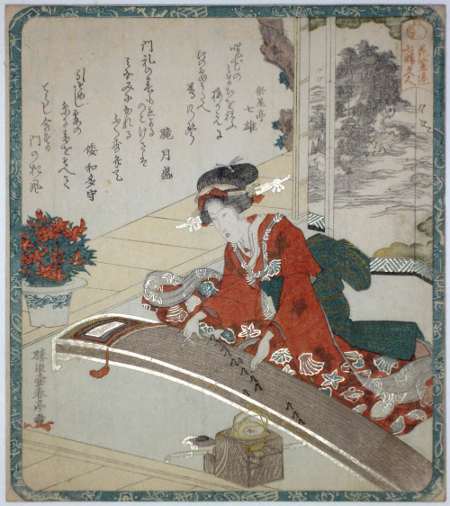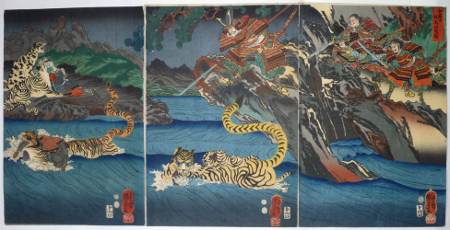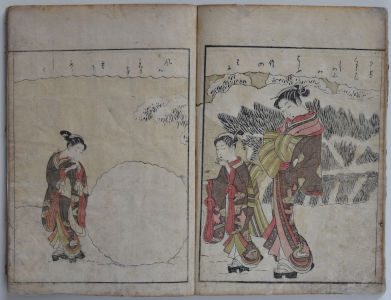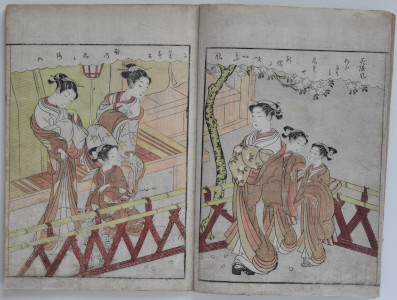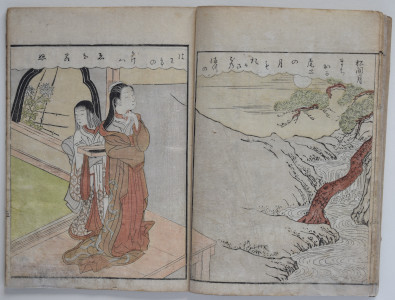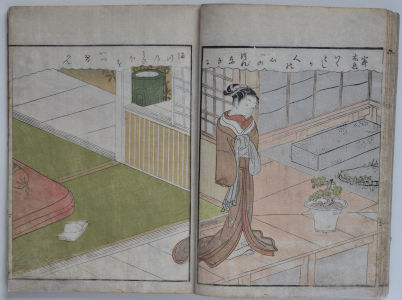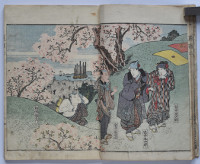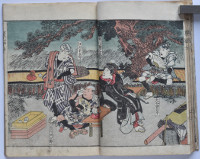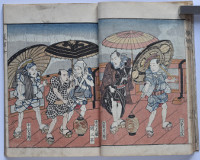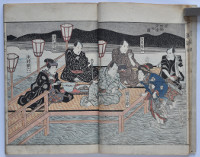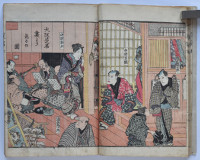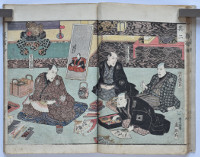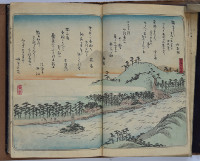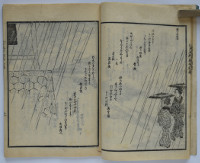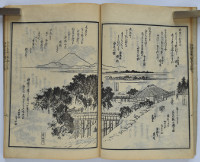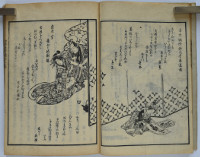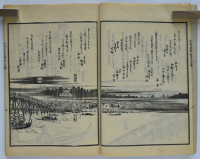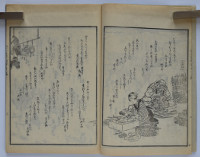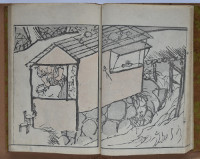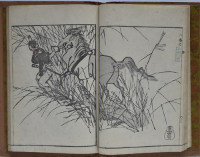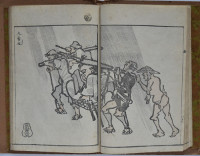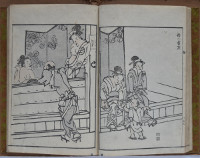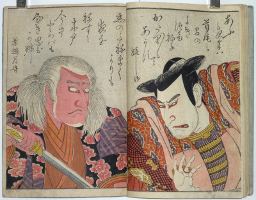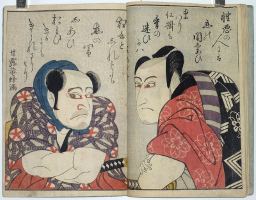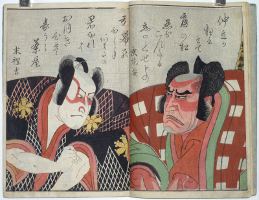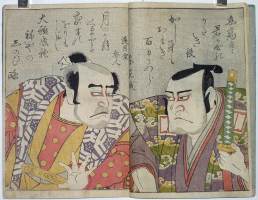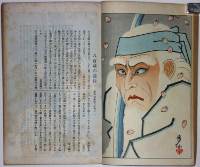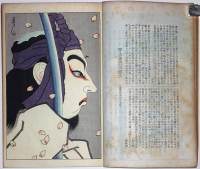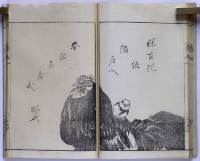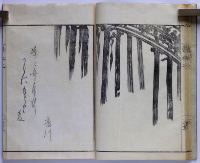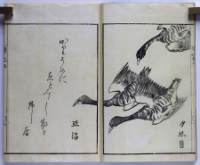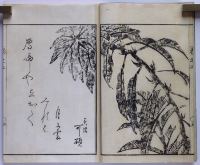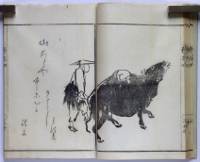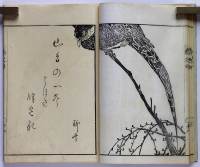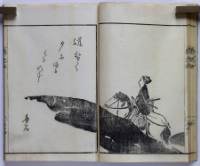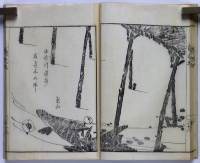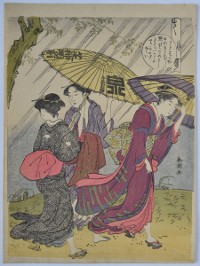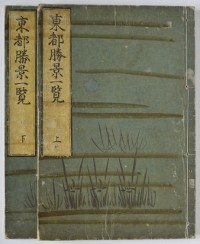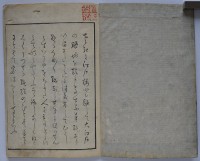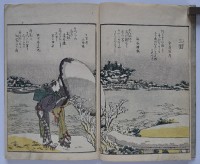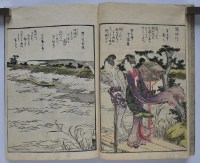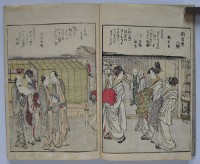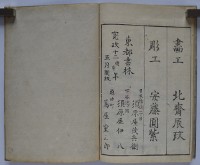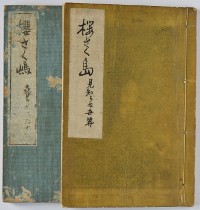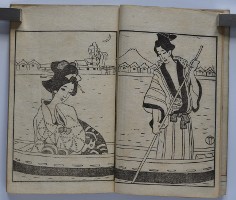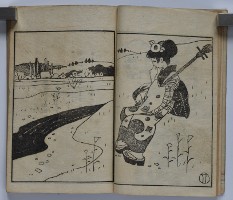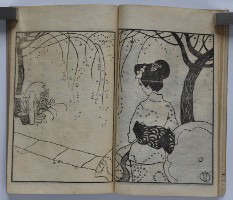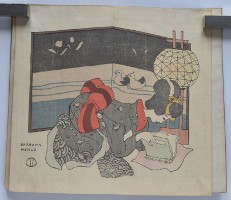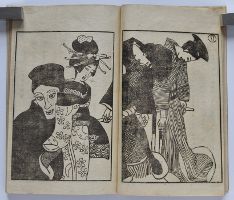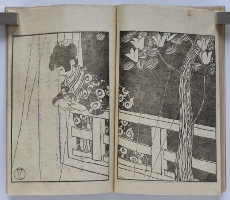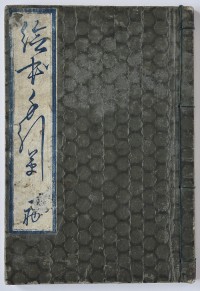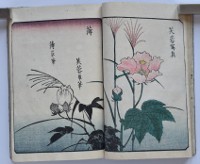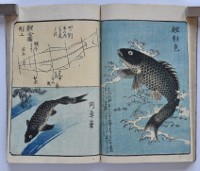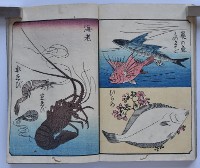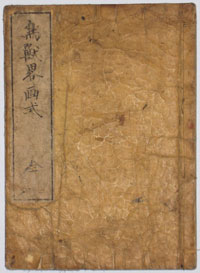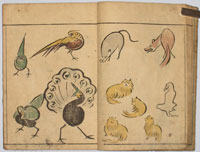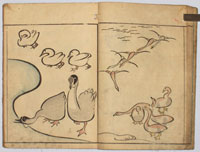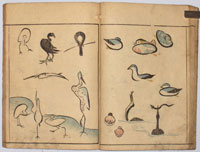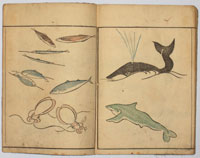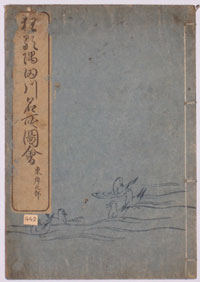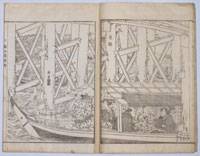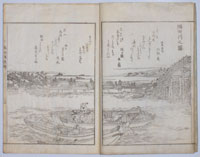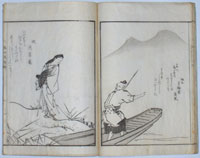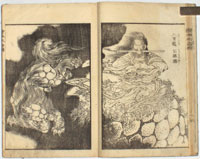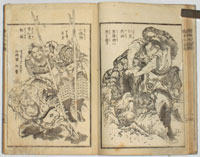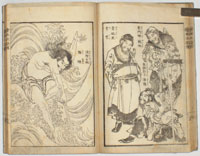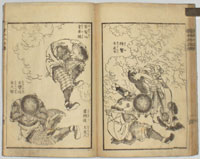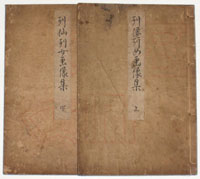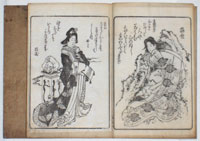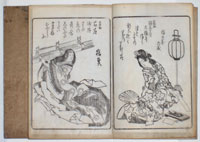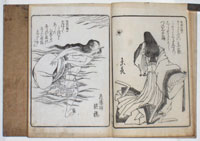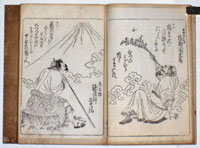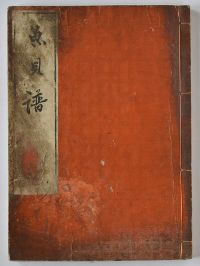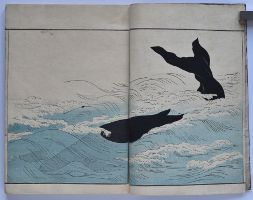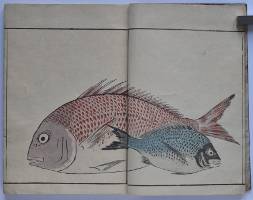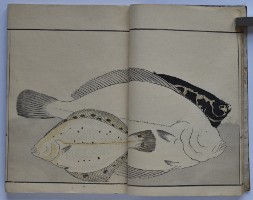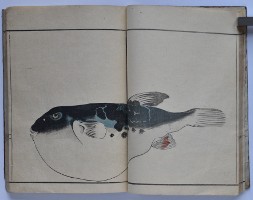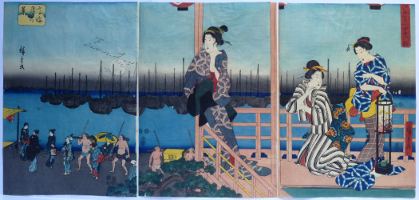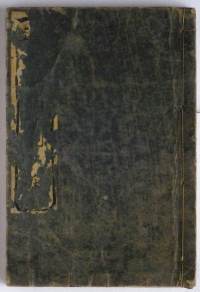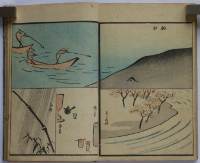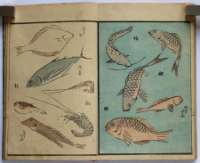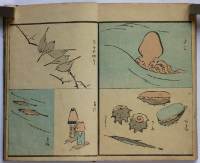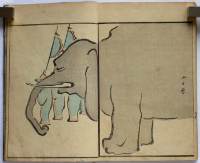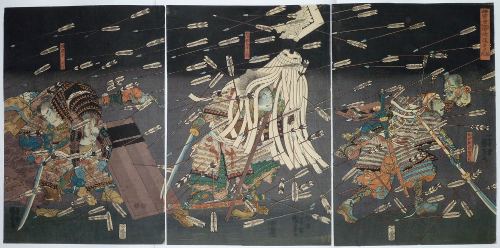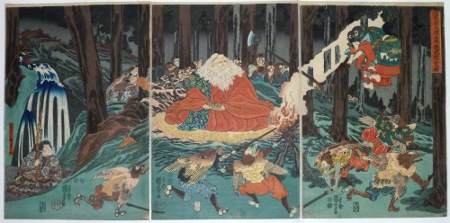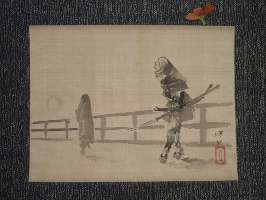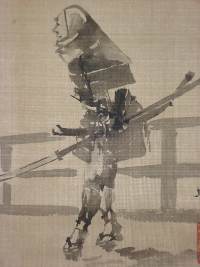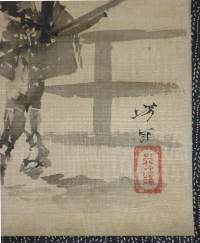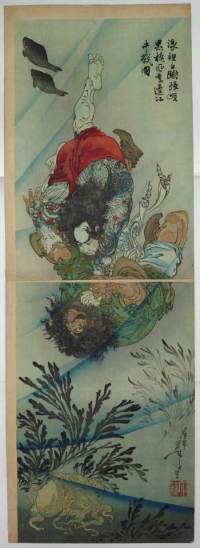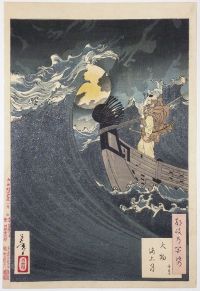Tsukioka YOSHITOSHI (1839-1892)
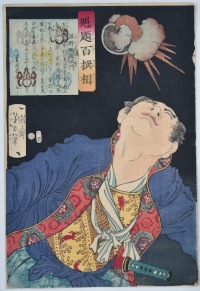
Click here to view image full size.
The samurai Shigeno Yozaemon looking up at an exploding houroku-hiya “hand grenade.” (As with so much in Japan, the grenade originated in China from early times.) From a set Kaidai hyaku, “Yoshitoshi’s Selection of One Hundred Warriors.” Sixty-five prints published by Ohashiya Yashichi between 1868 and 1869, this being 1869. The text in the square cartouches in this set refer to prominent warriors in the internecine wars of the 16th century but in fact the subjects are Shogitai soldiers. (Those that held out against the imperial forces and were massacred at Ueno, 4/7/1868.) An excellent set.
Fine impression, colour and condition. Signed Ikkaisai Yoshitoshi htsu.
Status: Sold
Tsukioka YOSHITOSHI (1839-1892)

Click here to view image full size.
Shigetsugu Munakata Kamon warming his hands in a snowstorm: Large flakes float down. From a set Kaidai hyaku, “Yoshitoshi’s Selection of One Hundred Warriors.” Sixty-five prints published by Ohashiya Yashichi between 1868 and 1869, this being 1869. The text in the square cartouches in this set refer to prominent warriors in the internecine wars of the 16th century but in fact the subjects are Shogitai soldiers. (Those that held out against the imperial forces and were massacred at Ueno, 4/7/1868.) An excellent set.
Fine impression, colour and condition. Signed Ikkaisai Yoshitoshi htsu.
Status: Sold
Tsukioka YOSHITOSHI (1839-1892)
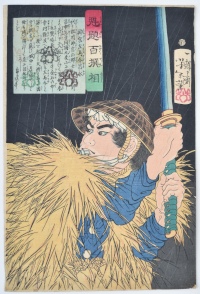
Click here to view image full size.
The warrior Jingu Samanosuke Masanaga holding a sword and wearing a mino (straw cape) in heavy rain. From a set Kaidai hyaku, “Yoshitoshi’s Selection of One Hundred Warriors.” Sixty-five prints published by Ohashiya Yashichi between 1868 and 1869, this being 1869. The text in the square cartouches in this set refer to prominent warriors in the internecine wars of the 16th century but in fact the subjects are Shogitai soldiers. (Those that held out against the imperial forces and were massacred at Ueno, 4/7/1868.) An excellent set.
Fine impression and colour. The rain printed in silver. Fine condition. Signed Ikkaisai Yoshitoshi htsu.
Status: Sold
Utagawa KUNISADA (1786-1865)
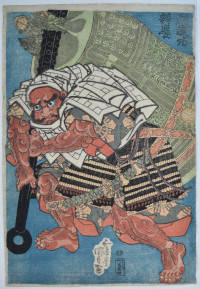
Click here to view image full size.
Shows Musashibo Benkei carrying the stolen giant Mii Temple bell up Mount Hiei to the Enryaku-ji, the Tendai-sect temple of the San-mon, “Mountain Order.” He is usually depicted dragging the half-ton bell, but here he is shown carrying it with the help of his kanabo, iron war club. Published by Daikokuya, c 1830-39. Another impression is in the British Museum, 1906,1220,0,1054. Rare.
Very good impression, colour and condition. Signed Gototei Kunisada ga.
Status: Sold
Katsukawa SHUN’EI (1762-1819)
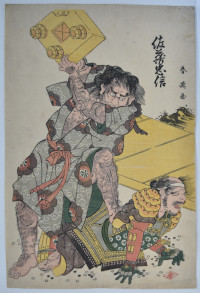
Click here to view image full size.
Shows the hirsute samurai Saito Tadanobu about to strike an adversary with a go board. This was a popular story relating to his death: He was attacked while playing go and used the heavy board to fight off his enemies. Published by Wakasaya Yoichi (Jakurindo), c 1810. Rare.
Fine impression, colour and condition. Signed Shun’ei ga.
Status: Sold
Kawanabe KYOSAI (1831-1889)
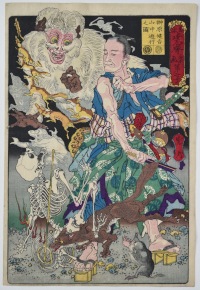
Click here to view image full size.
Shows the professional swordsman Kaibara Kenkichi travelling in the mountains from a set Kyosai rakuga, “Kyosai’s Drawings for Pleasure.” A satirical take on current events and mores. Generally considered the father of kendo. At the age of 13 he came under the tutelage of Seiichiro Odani to learn the art of swordplay and master its secrets. Became assistant instructor at the Kobusho in 1856. Famous for inventing the yamatozue, a wooden sword, and the ganko ogi, a wooden fan substitute for the wakizashi (short sword) when the decrees abolishing the wearing of swords in public was issued in 1876. Here he is surrounded by wild beasts and a skeleton. Published by Sawamuraya Seikichi in 1874. A set of 15 prints was planned but only 12 are known.
Very fine impression. Fine colour and condition. Signed Kyosai.
Status: Sold
Tsukioka YOSHITOSHI (1839-1892)
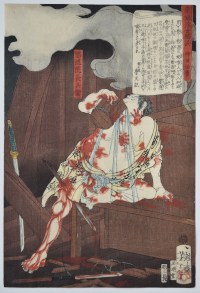
Click here to view image full size.
A design from the set Azuma no nishiki ukiyo kodan, “Tales of the Floating World on Eastern Brocade.” Kodan (traditional storytelling) raconteurs narrated Japanese folk stories, sometimes accompanying themselves with wooden blocks clapped together or a fan giving rhythm. The Kodan text is shown above. Having been popular from around 1700 (and known as Koshaku), these performances gained renewed popularity in the 1850s with the classic standards augmented by contemporary stories of heroes and villains. Here, the wounded and blood-smeared chief of the Edo otokodate, Banzuin Chobei, is seen drinking water in a bathhouse where he is treacherously murdered by Mizuno Jurozaemon. Various publishers from 1867-68, here Sekiguchi Gyokumeido, 10/1867.
Fine impression. Very good colour. Slight trimming, otherwise very good condtion. Signed Ikkaisai Yoshitoshi hitsu.
Status: Sold
Taiso YOSHITOSHI (1839-1892)
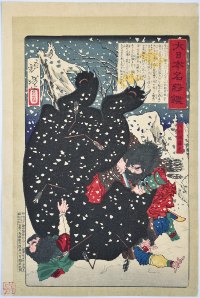
Click here to view image full size.
Shows Abe no Hirafu, a governor of Koshi, killing a giant bear in heavy snow. From a set: Dai Nippon meisho kagami, “Mirror of Famous Leaders of Great Japan.” Published by Funazu Chujiro, 1880.
Fine impression, colour and condition. Signed Oju Yoshitoshi hitsu.
Status: Sold
Ichiryusai HIROSHIGE (1797-1858)
Click here to view image full size.
An extremely rare uncut fan print: Spring Moon from a set Three Views of the Moon in the Eastern Capital. Shows two beauties on a restaurant veranda admiring a full moon. The other two designs from this set are illustrated in Hiroshige no uchiwae, Hiroshige Fan Prints, Okuda, Atsuko, Unsodo, 2010, nos 29 and 30, p 28 and 29. Published by Tsujiya Yasubei, c 1849-52. If not unique, then certainly one of the few impressions extant.
Very fine impression and colour. Very slight centre fold, otherwise fine condition. Signed Hiroshige ga.
Status: Sold
Ogata GEKKO (1859-1920)
Click here to view image full size.
An uncut fan print showing a great white egret. Rare.
Fine impression, colour and condition. Signed Gekko.
Status: Sold
Honda UNRIN (Active c. late Edo period)
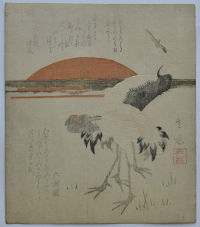
Click here to view image full size.
A surimono of a male and female red-crowned crane (aka Manchurian crane). Behind a huge setting sun. The crane represents good fortune, longevity and fidelity in Japan and is a popular subject for surimono. Unrin, a Nanga/Shijo artist, was a pupil of Tetsuo (1791-1871). Issued c. 1840s.
Fine impression with the birds outlines and plumage beautifully blind-printed. Very good colour. Minimal soil, otherwise very good condition. Signed and sealed Unrin.
Status: Sold
Utagawa HIROSHIGE (1797-1858)

Click here to view image full size.
Izumo, taisha Hotohoto no zu, “Izuma [Province], Hotohoto Festival at Izumo Shrine.” Shows pilgrims to the oldest Shinto shrine in Japan. A heavy mist scene with the torii gate seen to the right. Every year from the 11th to the 17th day of the 10th lunar month (usually November) all Shinto’s deities from around Japan supposedly assembled here. It is also the shrine to visit in the hope of finding a partner. From a set of 69 prints [Dai Nihon] Rokujuyoshi meisho zue, “Famous Places in the Sixty-odd Provinces [of Japan]” published by Koshimuraya Heisuke between 1853 and 1856, this being 1853.
Very fine impression and colour. Light album backing and very small wormhole at extreme edge of margin, top left, otherwise fine condition. Signed Hiroshige ga.
Status: Sold
Katsukawa SHUNTEI (1770-1820)
Click here to view image full size.
A woman playing a koto from the set: Hanagasa-ren Shichifukujin, “Seven Women as the Gods of Good Luck for the Hanagasa Club. Each beauty represents a god, presumably in this case Benten. The series may be a parody of the new year tradition of making a pilgrimage to the seven shrines devoted to each of the Seven Gods of Good Luck. The set of eight prints published c 1820.
Fine impression and colour with silver and gold. Light backing, otherwise very good condition. Signed Shokyuko Shuntei ga.
Status: Sold
Utagawa KUNIYOSHI (1797-1861)
Click here to view image full size.
A triptych showing Kato Kiyomasa (Watoni) and his henchmen watching Korean man-eating tigers carrying off their compatriots across a river. Watoni gunko toshu no zu. Hideyoshi sent Kiyomasa to Korea twice in 1592 and 1597. He is often depicted killing a man-eating tiger. Published by Yamaguchi-ya Tobei in 1855.
Very early fine impression with beautiful colour variation on the rocks at right. Fine colour. Slight edge crease near left edge of first sheet and imperceptible centre folds, otherwise very good condition. Signed Ichiyusai Kuniyoshi ga.
Status: Sold
Suzuki HARUNOBU (c 1725-1770)
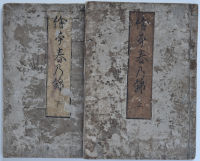
Click here to view image full size.
Two volumes complete: Ehon haru no nishiki, “Picture Book: The Brocades of Spring.” Vol. 1: 1 page preface dated Kanoto U (1770); single page and 8 double page colour prints. Vol. 2: 1 single page and 8 double page colour prints. 1 page colophon with date, publisher, block-cutter and artist as Suzuki Harunobu with his seal. 2 pages publisher’s announcements. Published by Yamazaki Kimbe, Edo. This is the first edition, Meiwa 8 (1771). Other copies are in the MFA, Boston, acc. no 1997.477.1-2 and Philadelphia Museum of Art, acc. no. 1970-46-1. Provenance: Ex collections H.M.Kaempfer and Hayashi (their seals on the first page of each volume). Original covers and title slips. Covers worn. Some soil and edge restoration. Very good impressions with generally very good colour. Rare in the first edition.
Status: Sold
Utagawa KUNISADA (1786-1864)
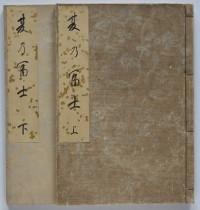
Click here to view image full size.
Two volumes complete Yakusha sugao natsu no Fuji, “Portraits of Actors Compared to Fuji in the Summer.” (In other words, without white makeup.) Vol. one: Preface signed Santoan Kyozan. Frontispiece illustration showing Mt. Fuji and nine double-page illustrations of actors and their acolytes in a variety of pursuits offstage. Postscript dated Bunsei 11 (1828). Vol: two: Preface by Tsuruya Namboku IV dated 9/1827. Frontispiece illustration showing a washbowl and fan and nine double-page illustrations of actors from Edo, Kyoto and Osaka. Postscript signed Kochoro Utagawa Kunisada ga with seal Gotokan to tekichoku ko and the publishers: Tsuruya Kiemon; Yamamoto Kyubei; Eijudo (Nishimuraya Yohachi); Kansendo (Izumiya Ichibei); Kinrindo (Moriya Jihei). This fascinating book shows actors in and around their residencies. Replaced title slips and covers. Fine impressions and very good colour. Minor marks and thumbing. Rare.
Status: Sold
Utagawa HIROSHIGE (1797-1858) and Utagawa YOSHITORA (active c. 1850-1880)
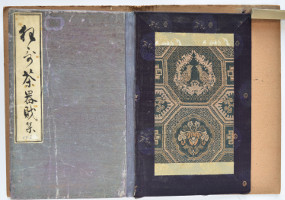
Click here to view image full size.
One volume complete Kyoka chakizai gazoshu, “Tea Ceremony Utensils, a Kyoka Collection.” Published Ansei 2, 1855 by Seiryuteizo. Inside front cover artists given as Ichiryusai Hiroshige and Ichimosai Yoshitora. Three pages preface; three pages decorative labels; four pages landscapes by Hiroshige (including the Uji River – a prime tea growing area); twelve pages of portraits by Yoshitora; twenty-one pages kyoka poems. Original covers with a hand inscribed title slip. Ex collection Edmond de Goncourt with his brocade binding and imitation wood slipcase. In very good condition.
Status: Sold
Utagawa HIROSHIGE (1797-1858)
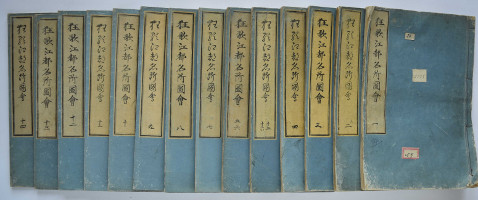
Click here to view image full size.
A complete set of Kyoka Edo meisho zue, “Collection of Pictures of the Famous Places of Edo in Kyoka.” Fourteen volumes (sixteen books) dated Ansei 3, 1856. Artist: Ryusai Hiroshige ga, with volumes fifteen and sixteen being by Hiroshige II. Compiler of poems: Tenmei Rojin. Publisher not given. Book 1: 25 sheets, 11 illustrations. Book 2: 24 sheets, 10 illustrations. Book 3: 23 sheets, 10 illustrations. Book 4: 19 sheets, 9 illustrations. Books 5-6: 34 sheets, 15 illustrations. Book 7: 22 sheets, 9 illustrations. Book 8: 21 sheets, 9 illustratins. Book 9: 22 sheets, 9 illustrations. Book 10: 21 sheets, 8 illustrations. Book 11: 14 sheets, 6 illustrations. Book 12: 18 sheets, 7 illustrations. Book 13: 16 sheets, 6 illustrations. Book 14: 16 sheets, 8 illustrations. Books 15-16: 23 sheets, 9 illustrations. The monochrome illustrations show the popular life of Edo as well as the views. Original covers and title slips.
In very good condition. Rare complete.
Status: Sold
Kawamura BUMPO (1779-1821) and Watanabe NANGAKU (1763-1813)
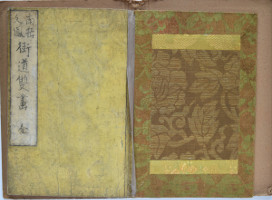
Click here to view image full size.
One volume complete Kaido kyoka awase, “Comparison of Kyoka Poems on the Highway.” Three pages preface signed Bumpo and thirty-six double-page illustrations alternating by Nangaku and Bumpo; last page colophon dated Bunka 8 (1811) with artists Nangaku Tseki and Bumpo Basei. Publishers Kawachiya Kihei, Osaka, and Yoshidaya Shimbei, Kyoto. Original embossed yellow covers with original title slip. Originally published in two volumes with the poems in volume one and almost immediately reissued as a one volume work, as here. Numerous collectors’ seals: Tanido Kyohitsu, Seiyo Kosetsu, and Edmond de Goncourt with his brocade binding and imitation wood slipcase. A beautiful example of this fine Shijo book in very good condition.
Status: Sold
Utagawa TOYOKUNI (1769-1825)
Click here to view image full size.
One of Toyokuni’s most famous books: 2 volumes bound as one, Yakusha Awase Kagami, “A Mirror of Actors’ Physiognomy.” Published Kyowa 4 (1804) by Bunshundo and Yamadaya Sanshiro. Vol. I, 4pp. preface, undated, 18 single-page half-length portraits of actors below kyoka poems. Vol. II, 15 single-page half-length portraits, followed by single page poem signed Ichikawa Hakuen (Danjuro V), 4pp. postscript, signed Kankoku. Lacking original covers with publisher Toto Banshundo on inside cover of Vol. I. Also lacking 2pp. second postscript by Banshundo and colophon. Very minor soil and three portraits with colour turned, otherwise very fresh impressions. Extremely Rare.
Status: Sold
[Shiba] Shin nigao-e (Published 1915)
Click here to view image full size.
Five volumes complete: [Shibai] Shin nigao-e. Published in Tokyo Taisho 4 (1915) and illustrated by Natori Shunsen, Yamamura Koka, Torii Kotondo, Ishida Hakutei and others.
Volume one: 18.5 x 12.5 cm. Original covers, beige. The abbreviated title: Shin nigao and volume number are printed directly on the cover. On the right is the publication date, June 1, Taisho 4 (1915), and a note that subsequent numbers will be published on the first day of each month. Table of contents. Preface by Kinoshita Sataro. The fourteen colour woodcut portraits are by Natori Shunsen (5), Matsuda Seifu (4), Yamamura Koka (3), Torii Kotondo (1), and Ogawa Heibei (1). Block cutter: Igami Bonkotsu. Printer: Namamura Sanjiro. The text on actors and roles are mainly printed on tissue interleaves. Colophon page, dated June 1, Taisho 4 (1915). Compiler: Egawa Kinpei. Published by Nigao-do.
Volume two: 25.2 x 18.7 cm. Covers, light blue. The abbreviated title and volume number are printed directly on the cover. The first actor print is pasted to the cover, credited internally to Natori Shunsen. Front endpaper, table of contents. The forteen woodcut portraits are by Shunsen (4, including the cover), Koka (3), Terazawa Kotaro (2), Isshii Hakutei (2), Matsuda Seifu (2), Heibei (1). Colophon, dated July 1, Taisho 4; otherwise as Vol. one.
Volume three: 25.2 x 18.7 cm. Covers, beige. Title and volume number as for Vol. two. The first actor print is pasted to the cover, as above. The fourteen actor portraits are by: Shunsen (5), Seifu (3), Hakutei (3), Koka (2), and Heibei (1). Colophon dated August 1; otherwise, as above.
Volume four: 25.2 x 18.5 cm. Covers light blue in the same format as above. The fourteen actor portraits are by: Shunsen (5), Koka (4), Hakutei (2), Seifu (2), Heibei (1). Colophon dated October 1; otherwise, as above. Back cover, an ad for forthcoming special Coronation issue of Shin nigao.
Volume five: 25.1 x 18.6 cm. Covers, grey paper embedded with green fibres over stiff boards, bound with green silk tassels. The title, Shin nigao-kinen-go: Tairei Hoshoku gafu, “Shin nigao: Special Coronation Number” is printed directly on the cover. The format is basically the same, but two special sections have been added: five portraits of officials associated with Emperor Taisho’s coronation, and five portraits of geisha from Tokyo and Kyoto. The remaining eleven prints are of actors, for a total of twenty-one colour woodcuts: Shunsen (11), Heibei (3), Seifu (3), Ishizuka Kan (2), Kondo Hiroshi (1), and Koito Gentaro (1). Colophon dated November 1, Taisho 4 (1915), otherwise as above.
This set contains the earliest prints by Natori Shunsen and gave the impetus to have the larger actor portraits published. In slipcase. Very good condition.
Status: Sold
Cho GESSHO (1772-1832) and Kazaore YUJO (fl. c. 1790-1800)
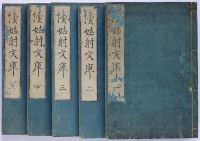
Click here to view image full size.
5 vols. complete: Zoku Koya Bunko, “The Sequel to Koya Library.” Vol. 1: 52 sheets; 48 illus. Vol. 2: 49 sheets; 48 illus. Vol. 3: 53 sheets; 51 illus. Vol. 4: 53 sheets; 52 illus. Vol. 5: 56 sheets; 54 illus. Preface, 5 pp. by Kogetsutei, dated Kansai 9 (1797). Artists: Kazaore Yujo and Cho Gessho. Published by Fugetsu Magosuke, Nagoya, Kansai 10 (1798), together with other publishers in Edo, Osaka and Kyoto. The greatest anthology of printed haiga (haiku poems accompanied by illustrations based on simple, yet often profound, observations of everyday life). The anthology was started by Yujo but taken over by Gessho on his death. Most of the work is Gessho’s. This is one of the few books where the block-cutter and printer must take pride of place beside the artist. The most striking effects were achieved by these artisans by imaginative working of the block surface and wiping of the blocks to produce distinctive variations in texture and formless adumbrations of trees, plants and landscapes, all in sumi. Other examples: Duret 464 (5 vols. 1799); Gonse (III), 438 (4 vols., 1798); Holloway 18; Ryerson, pl. XI. Original covers and title slips. Some slight damage to covers and slight restored wormage at bottom of first sheets of vol. 1. But otherwise an exceptionally fine and clean copy with hardly any thumbing on corners. A lovely and rare set.
Status: Sold
Katsukawa SHUNCHO (Fl. c. 1780-1795)
Click here to view image full size.
A chuban print showing a group of beauties caught in a downpour on the banks of a river. The centre figure has an umbrella with the publisher’s name Izumi [ya Ichibei] and address Shiba Jinmeimae which was in front of Shiba Daijingu Shrine. One of a set Nana Komachi, “The Seven Komachi,” being episodes in the life of the famous waka poetess Ono no Komachi (c. 825-c. 900). Little is known of Shuncho’s life except that he was a pupil of Katsukawa Shunsho and was then heavily influenced by Kiyonaga. He produced some particularly fine triptychs and pillar prints. Published c. early 1790s.
Superb impression, colour and condition: As the day it was printed. Signed Shuncho ga.
Status: Sold
Katsushika HOKUSAI (1760-1849)
Click here to view image full size.
Two volumes complete: Toto shokei ichiran, “Fine Views of the Eastern [Edo] Capital at a Glance.” Shows famous places in Edo with accompanying kyoka poems at the top. Volume 1: 10 sheets, 1 p. preface. Volume 2: 11 sheets with colophon giving date Kwansei 12 (1800). Publishers Tsutaya Jusaburo, Suharaya Mohei and Suharaya Ihachi. Ando Enshi engraver and artist Hokusai shinsei. This book was first published with title Toto meisho ichiran by Tsutaya Jusaburo. Shortly afterwards the title was changed and the two other publishers joined Tsutaya Jusaburo. This is the edition offered here. Original hand-painted covers with a decoration of iris flowers and water (only found on the original edition). The blocks were subsequently sold to the Nagoya publisher Hishiya Kinbei who reissued it in 1815 together with Suharaya Mohei and Ihachi. The blocks were yet again sold, this time to Kawachiya Mohei who issued another reprint in 1840 with the above publishers. A lovely early example of this famous book. Cover and title slips in very good condition.
One wormhole affecting last 4 pages at the top outside image area, otherwise contents fine and clean. Provenance: Large seal of Hayashi Tadamasa at the start to each volume.
Status: Sold
Takehisa YUMEJI (1884-1934)
Click here to view image full size.
One volume complete Sakura-saku shima : Haru no kawatare. Title page: Within purple borders, the subtitle and Yumeji-saku in reddish brown. Frontispiece: colour woodcut across two pages entitled TUMABIKI, “Finger-plucking” in roman letters, with decorative seal. One page introduction by Yumeji. The remaining 50 pages (unnumbered) with poems by Yumeji and ten double-page and four single-page b/w woodcuts, all dealing with emotions associated with springtime. Colophon dated Meiji 45 (1912), first printing. Artist/author: Takehisa Yumeji. Publisher Kawamoto Kamenosuke. Publishing house Rakuyodo. One page ad for the four books then planned but only this and the following Sakura-saku shima: Mi shiranu sekai were produced. Original pale blue covers with original title slip. In very good condition. Wonderful early designs before becoming overly cloying.
Sold together with: Sakura-saku shima: Mi shiranu sekai. Title page: Within black borders, the subtitle and Yumeji-saku in black, flanked by images of two demons, one red, the other green. Frontispiece: colour woodcut across two pages entitled UNKNOWN WORLD in roman letters, with decorative seal. The remaining 46 pages (unnumbered) with poems by Yumeji and ten double-page b/w woodcuts dealing with family relations and images of souls in hell. Colophon dated Meiji 45 (1912), first printing. Artist/author: Takehisa Yumeji. Publisher: Kawamoto Kamenosuke. Publishing house: Rakuyodo. Original yellow covers with title slip. In very good condition.
Status: Sold
Ichiryusai HIROSHIGE (1797-1858)
Click here to view image full size.
One volume complete, Ehon tebikigusa, “A Model Book of Plants.” Published by Iseya Rihei, 1849. Signed on inside of front cover Ichiryusai Hiroshige hitsu with three page preface signed Ryukatei Tanekazu (1807-1858) plus one page introduction by Hiroshige on how he was asked to design a book as a guide to drawing for children. (See Strange, The Colour Prints of Hiroshige, Cassell, 1925, p. 112-114 for a full translation.) Thirty-five pages of flowers, grasses and fish plus two page view of Mt. Fuji and last page signed Ichiryusai. This is the rare first edition: It was republished by Shojuya Shoshichi, lacking the introduction. Original embossed grey covers and blue title slip.
Extremely fine impressions. Some slight edge wormage at end, otherwise very good condition.
Status: Sold
Kitao MASAYOSHI (1764-1824)
Click here to view image full size.
One volume complete Choju ryakugashiki, “Simplified Forms of Drawing Birds and Flowers.” Published Kwansei 9, 1797, by Suharaya Ichibei. Illustrated by Kuwagata Keisai ( Masayoshi ). These influential books of Masayoshi’s were popular and were reprinted many times.
Fine early copy. Original title slip and lemon-yellow covers ( some wear ). Some thumbing at bottom especially towards front, and other minor marks, otherwise good condition. Unidentified collectors’ seals at end and small annotation on back cover of a previous (?) collector: L. de la Bedollier.
Status: Sold
Teisai HOKUBA (177 -1844)
Click here to view image full size.
One volume complete Kyoka sumidagawa meisho zue, ” Humorous Poems on Famous Views of the Sumida River.” Colophon dated Bunsei 6, 1823, published by Shunsuien. Extremely rare.
Original covers with a printed design of chidori. Original title slip. Very good condition.
Status: Sold
Utgawa HIROSHIGE (1797-1858)
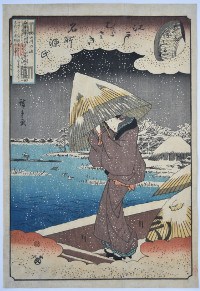
Click here to view image full size.
One of a set: Edo Murasaki meisho Genji, “Murasaki’s Genji in Famous Places of Edo.” Mitate Ukifune Sumidagawa no watashi, “A Parody of Ukifune Crossing the Sumida River.” Shows a beauty on a ferry crossing the Sumida River in heavy snow, representing Ukifune, one of the court ladies of the Genji Monogatari. Stylised clouds above and below copying the traditional kiri-gane gold found on Yamato-e scrolls. These Genji pictures were popular at this time to circumvent the reforms of 1842. Published by Kinseido (his seal also appearing on the umbrella bottom right). A rare set.
Fine impression. Very good colour. Minor soil, otherwise very good condition. Signed Hiroshige ga.
Status: Sold
Katsushika HOKUSAI (1760–1849)
Click here to view image full size.
One volume complete Ehon Suikoden, “A Picture Book of the Suikoden”, published by Kadomaruya Jinsuke, Bunsei 12, 1829 showing 108 Chinese brigands. Some fine designs. Signed Katsushika Zen Hokusai I-itsu fude.
Fine impressions. Original covers lacking title slip. Some slight foxing and minor marks.
Status: Sold
Yashima GAKUTEI (1786-1868) and Totoya HOKKEI (1780-1850)
Click here to view image full size.
Two vols. kyoka books complete: Ressen retsujo gazoshu, a “Collection of the Portraits of Immortal Men and Women.” Twenty eight portraits of Chinese hermits and twenty one portraits of celebrated women in Japanese history. Being a selection of kyoka presented at the meetimg held at Kawachiya of Yanagibashi Ryogoku in Edo, 1st day of the 9th month, Bunsei 7 ( 1824 ). Published by Shinsenyen. Rare.
Original covers and title slips. Minor marks to covers, otherwise very good condition.
Status: Sold
Keisai MASAYOSHI (1764-1824)
Click here to view image full size.
One volume complete Gyokai ryakugashiki, “Fishes and Shells in the Abbreviated Style of Drawing.” Published in Osaka by Fukusada Tobei, 1813. Originally published in 1802 with alternative title and poems by Ichiyosei Sogai and others. 31 sheets numbered 1-31. Initial page with title and illustrator Kuwagata Keisai (Kitao Masayoshi). Colophon with date Bunka 10 (1813), engravers and publisher.
Some minor soil and damage to covers, otherwise good condition. Extensive use of mica on various pages.
Status: Sold
Ichiryusai HIROSHIGE (1797-1858)
Click here to view image full size.
Autumn from a set of four triptychs, Edo meisho shiki-no nagame, “Famous Places in Edo in the Four Seasons.” An evening scene with beauties on a balcony overlooking the bay at Takanawa. Birds are descending across a full moon. Published by Marujin, 1848-9. All four triptychs from this set are masterpieces.
Fine impression. Perfect colour. Slight thinning and creasing, otherwise fine condition. Signed Hiroshige ga.
Status: Sold
Ichiryusai HIROSHIGE (1797-1858)
Click here to view image full size.
A copy of Ryakuga Korin-fu Ryusai hyakuza, the One Hundred Abbreviated Drawings by Ryusai [Hiroshige]. 1 vol. complete: 21 sheets; inside front cover title and illustrator Hiroshige (also given on last page). 3pp. preface dated Kaei 4 (1851) and signed Ryukatei Tanekazu and 20 pages, numbered, with illustrations in sumi, blue and pink. Colophon inside back cover with a list of bookshops (?) in Osaka and Edo and publisher Yoshidaya Genpachi. According to Brown (L.N.Brown, Block Printing And Book Illustration In Japan , George Routledge & Sons Ltd. 1924, p. 195) this book was republished as vol. IV of Sohitsu gafu. Original covers, missing title slip. Contents very good with only minor marks.
Status: Sold
Utagawa KUNIYOSHI (1797-1861)
Click here to view image full size.
Nanke yushi Shijo-nawate nite uchijini. The last stand of the Kusunoki clan at Shijo-nawate in 1348. Kusunoki Masatsura, shown on the far left propped against his fallen horse under a rain of arrows, continues his father’s struggle against the Ashikaga forces. Wada Shinbochi (Genshu) leads the way holding enemy heads followed by Masatomo with a battle standard. Their blue complexions anticipate their imminent demise. Published by Fujioka-ya Keijiro, 1851-2. Robinson T271.
Fine impression. One small backed wormhole on title, otherwise very good condition. Full size. Signed Ichiyusai Kuniyoshi ga.
Status: Sold
Utagawa KUNIYOSHI (1797-1861)
Click here to view image full size.
A triptych showing Ushiwaka Maru (Minamoto no Yoshitsune’s childhood name), attended by Kisanda, practising fencing with the karasu or “crow” tengu in a forest glade on Mt Kurama, north of Kyoto. His training in martial arts is being supervised by a white-bearded yamabushi tengu, Sojobo, King of the Tengu. (The yamabushi were followers of Shugendo – a shamanistic mountain ascetism.) Yoshitsune (1159-1189) is the best known Japanese warrior and a popular subject for Japanese artists and craftsmen. Famous for exploits such as the battle on Gojo Bridge with Benkei and the battle of Dan-no-ura. Published by Enshuya Hikobei, 1851-2. Robinson T264.
Fine impression. This is the first state with gradation on the rocks top left. Fine colour. Very good condition. Signed Ichiyusai Kuniyoshi ga.
Status: Sold
Utagawa KUNIYOSHI (1797-1861)
Click here to view image full size.
An extremely rare diptych showing Princess Wakana (left) played by Bando Shuka I and the warriors Genkai Nadaemon played by Arashi Rikan III; Washizu Rokuro played by Arashi Rikaku II; Wachizu Shichoro played by Bando Takesaburo I. The play Shiranui monogatari, “The Tale of the White Embroiderer” was performed at the Kawarazaki Theatre, 2/1853. The story (from a late Edo novel) tells of the feud between Wakana and the Kikuchi clan who killed her family. She is rescued by a spider who gives her the power of spider magic which, with the aid of a spider scroll, enables her to conjure up a giant spider to assist her. Published by Kakumoto-ya Kinjiro. This is the only complete impression I have seen and I can only find one other recorded example (listed in the Kuniyoshi Project).
Fine impression and colour. Small edge binding holes, otherwise fine condition Signed Ichiyusai Kuniyoshi ga.
Status: Sold
Tsukioka YOSHITOSHI (1839-1892)
Click here to view image full size.
An original painting showing what is probably the most famous encounter in Japanese mythology: The scene is evening on Gojo Bridge in Kyoto where the twenty year old Benkei ambushes samurai to steal their swords. He is shown approaching the flute-playing Yoshitsune. A fight ensues which Yoshitsune wins due to his leaping ability taught to him by the mountain tengu. Yoshitsune pardons Benkei and they become loyal friends. This painting, in shades of sumi, beautifully evokes the crepuscular gloom. On silk, 7 x 9.5 in; 17.75 x 24.1 cms. Painted c late 1870s. Signed Yoshitoshi with Taiso seal.
Status: Sold
Tsukioka YOSHITOSHI (1839-1892)
Click here to view image full size.
A vertical diptych showing Cho Jun, the white stripe in the waves, wrestling in the river with Ri Ki, the black whirlwind. Ronhakucho Chojun kokusempu Riki kochu ni tatakau no zu. The story concerns the river pirate, Ri Ki, who is caught stealing fish by Cho Jun and the ensuing underwater battle. Initially, Ri Ki has the upper hand but Cho Jun challenges him again and they fight until Ri Ki’s compatriots stop the engagement and invite Cho Jun to join their gang. Published by Matsui Eikichi, 1887. This is the extremely rare first state before the publisher and date in left margin. See my blog.
Very fine impression. Fine colour. Slight discolouration to top margins, otherwise fine condition. Full margins all round with ample room for joining. Signed Oju Yoshitoshi hitsu.
Status: Sold
Tsukioka YOSHITOSHI (1839-1892)
Click here to view image full size.
The best design from the set Tsuki hyakushi, the “Hundred Phases of the Moon”. The set published between 1885 and 1892 ( this being 1886 ) by Akiyama Buemon. Benkei against a full moon. In 1185 Yoshitsune attacked by his half-brother Minamoto no Yoritomo, was forced to flee to northern Japan by ship. Sailing along the Inland Sea off the coast of Harima Province not far from Kyoto, the ship was struck by a storm in Daimotsu Bay caused by the vengeful ghosts of the Taira warriors Yoshitsune and his men had slain. Benkei pacified the spirits in the prow of the boat by holding up his string of prayer beads.
Fine impression, colour and condition. (A good guide to the quality of the impression is to look at the outline of Benkei’s face: This fine line started to break down early on.) An impression that has not been in an album: Full margins with very extensive mica. Signed Yoshitoshi.
Status: Sold
